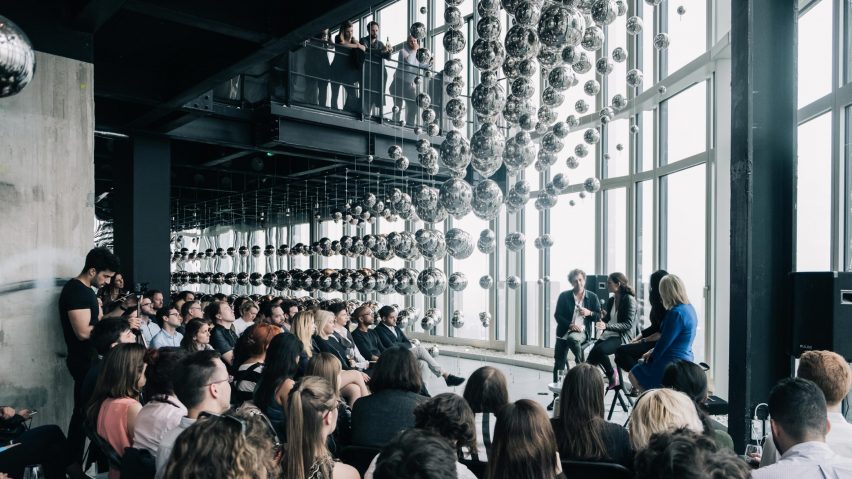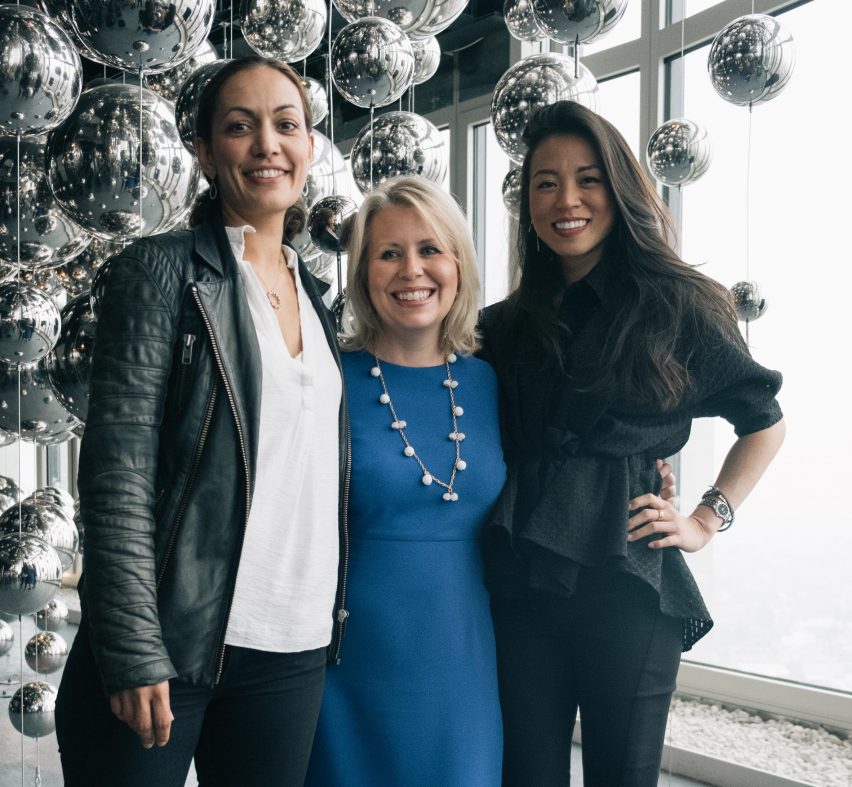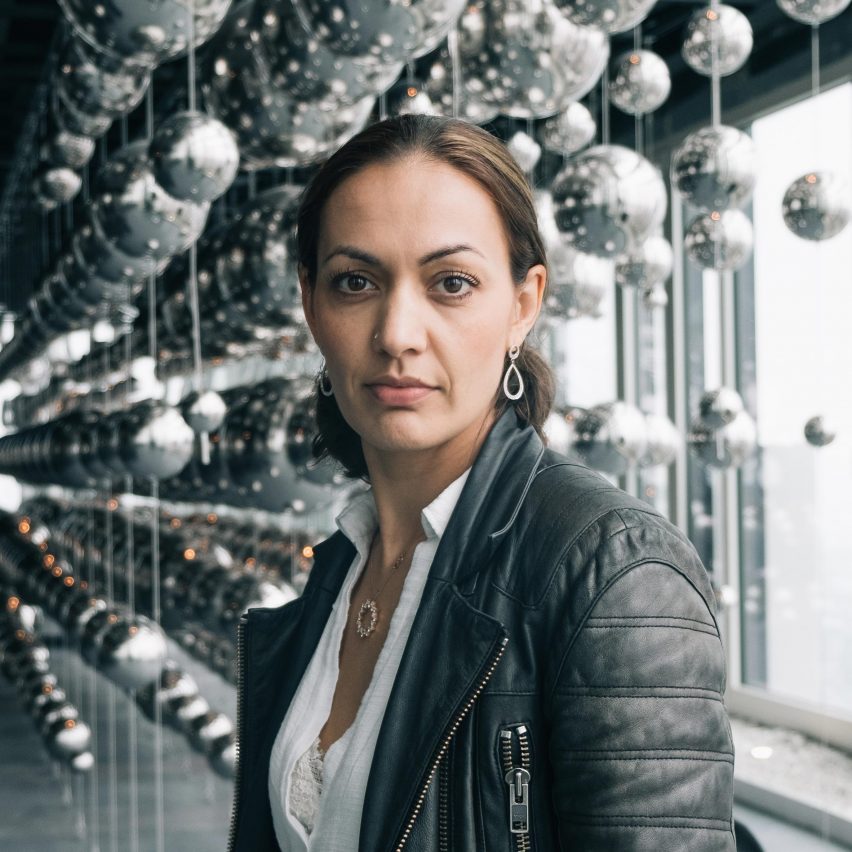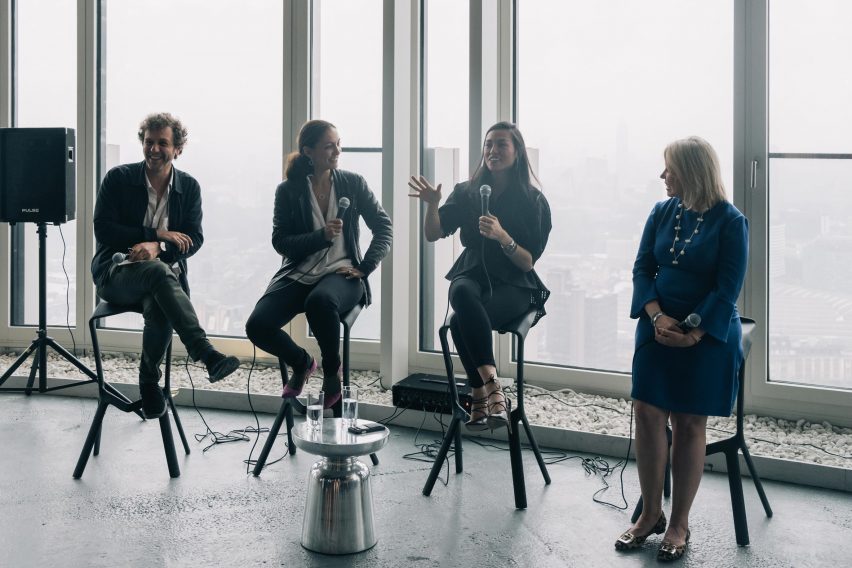
"Don't spend money you don't have" and "don't be afraid to be an asshole," architects advised
Getting paid on time, finding time to have children and dealing with long-hours culture were among topics discussed by executives from BIG, Zaha Hadid Architects and Design Haus Liberty at a business talk hosted by Dezeen in London last month.
"Don't hand over your drawings if the client hasn't paid," was the first tip provided by BIG's chief executive Sheela Maini Søgaard, who revealed that she got her job 10 years ago by scrawling this and two other snippets of advice on a napkin during her first meeting with BIG founder Bjarke Ingels.
"Bjarke said he was having trouble with clients who weren't paying the bills," recalls Søgaard, who previously worked in the food industry, including a stint with celebrity Danish chef Claus Meyer.
"So I just wrote three things down on a napkin," she added, saying she found time between child-nursing duties to meet Ingels in Copenhagen on the suggestion of a mutual friend.
Two weeks later, Ingels called her to say the tips were working – and to offer her a job. BIG has since ballooned to 470 staff split across studios in Copenhagen, London and New York, where both Ingels and Søgaard are now based.
Søgaard said her job is "to establish and maintain processes for everything that isn't design". She is the only female partner at the firm – a fact that brought her unintentionally into the spotlight recently.

Søgaard was joined on the panel by Design Haus Liberty founder Dara Huang and Zaha Hadid Architects' global head of people and talent Caroline Roberts. It took place in a penthouse inside South Bank Tower, where Huang's studio has created a sculptural installation.
During the talk, which was moderated by Dezeen founder Marcus Fairs and titled Executive Talk: Business of Design, the three talked about their career paths and offered business advice to architects.
Starting a business with no business skills
"I'm your classic designer with no business skills that started a business," said London-based architect Huang, who started her firm four years ago and now employs 26 people.
"We're not taught this in school. We're not taught how to run a business and start a family. When you start your own company you have to wear every single hat until you can afford to do it otherwise."
Huang asked Søgaard about the other two tips she scrawled on Ingels' napkin.
"One of them was not to start work until you had an agreement with the client on the terms and conditions," Søgaard said. "And the other was not to spend money you don't have."
"We laugh, but as designers we're passionate and we want to get things built," replied Huang.
"Unlike other businesses, we don't start with an exit strategy in mind," she added. "We literally want to do this until we can't walk any more. It's our passion and we'll do it whether we're paid or not."
Besides her architecture firm, which she started in 2013, Huang now also heads architectural lighting firm Design Haus Liberty Lux and is about to launch a third company, which will explore high-tech ways of delivering social housing.
"When you start your own company you have to wear every single hat until you can afford to do it otherwise," she said, but added that she hired a CEO after two years in business, saying: "You have to find out what you're best at and shuffle off the things you're not good at as soon as possible."
Bringing architecture business into the 21st century
Roberts took up her position at Zaha Hadid Architects under difficult circumstances. After previous stints as a musician and a programme maker for BBC radio, she was interviewed for the role of global head of people and talent last year, just before Hadid died unexpectedly of a heart attack.
"I had my final interview in her flat," Roberts recalled. "She looked me up and down. I'd had an in-depth interview with her business partner Patrik Schumacher but with Zaha, it took just half a dozen words for her to work out if I was the right person or not."
"It was two weeks before her death and I joined the company the week before Brexit," she added. "Everyone told me Brexit wouldn't happen so I wouldn't have to prepare. But I did. When you've got a workforce that is about 65 percent from the EU, it certainly was a baptism of fire."

Roberts was critical of working practices in the architecture sector. "As an HR professional I do notice that architecture is not exactly ahead of the curve," she said. "There needs to be more questioning in the architecture profession about how things are done, to bring it into the twenty-first century."
She felt the long-hours culture is instilled at architecture schools.
"At universities people are expected to really put long hours in," Roberts said. "Having worked long hours myself, I know my best creative work is not done at 5am in the morning. I think there's still a culture of, 'are you tough enough to make it?' Being tough enough is being able to work for 24 hours. There's still that element in many practices."
Combating architecture's long-hours culture
However Søgaard felt that the nature of architecture competitions meant that intense periods of work were unavoidable.
"We get at least 50 percent of our assignments through competition, so we're constantly running against the clock and running against someone else who wants to do something better," she said. "That generates the need for making it as good as we possibly can. I don't know that I agree that the best ideas don't occur at unsociable hours, because in our office they sometimes do."
She added: "As an employer we have to curb our employees enthusiasm. It's rare that they come to us and say they're working too much."
Huang has introduced flexible working hours in order to make work fit better with employee's lives. "Some people have families, some people need to leave at 4pm" she said. "Some people work better in the night and some people work better in the morning. Our admin team work from home one day a week."
"It's all about trust at the end of the day," she added. "Once you've worked with someone long enough and know they're going to produce a certain amount, you don't care where they are.They don't have to be sitting at their desk," she added."
"We this week introduced flexible hours because we're a young company but some people have families now, some people need to leave at 4pm, some people work better in the night and some people work better in the morning," said Huang.
Having worked outside architecture, both Roberts and Søgaard agreed that creative people are more rewarding to manage than non-creatives.
"Creative people don't put up with so much shit," said Roberts. "We're dealing with a very intelligent workforce. It presents a great opportunity because if you've got a problem in the workforce you've got lots of creative brains who can come up with a better solution. I prefer it."
"It's easier to manage creative because they're very passionate about what they do," agreed Søgaard. "And also because they have no interest in doing what my team does."
Addressing the gender pay gap
The conversation moved on to the gender pay gap. Roberts pointed out that, starting in April next year, all UK firms with more than 250 employees will be required by law to publish details of the gender pay gap in their organisations.
"At the moment the gender pay gap in architecture is about 24 per cent but the national average is about 18 per cent, so we're not so far away now," Roberts said. "We've introduced changes including flexible hours, holiday purchase to make it more attractive not just to women but to everybody."
Roberts said her firm has a "huge tranche" of talented women at associate director and senior associate level. "They are just brilliant leaders," she said. "They're the people who really inspire me and who are going to be the next generation."
"I've found it quite a positive thing to be a woman, to be not British, to be a minority," said Huang. "It's a state of mind. You have to embrace that. You have to own the room and get people to believe your vision and go the extra mile. This gender thing is only an issue if you make it an issue."

While Søgaard is currently the only female partner at BIG, she said that nearly 60 per cent of mid-level managers at the firm are women.
But she added: "I really struggle with how to wrap my head around the gender issue. We are on our way but there is an issue. I do think we're moving towards a betterment but I've come to the conclusion that we do have an assignment to secure more opportunities for women and to think about our biases."
Architecture businesses have to be more prepared for the unexpected than most other types of firms, the panel agreed.
"There's always something that means that a project is cancelled or has to move faster, essentially the schedule changes and you are in constant financial turmoil," said Søgaard. "I haven't experienced that in any other industry to the same extent."
She explained that last year over two dozen jobs at the firm were put in jeopardy when the Two World Trade Center tower in Manhattan was put on hold as Fox – the main tenant – pulled out.
"We got a call saying the client pulled out – they were taking 50 per cent of the building – so the developer ordered 'pencils down, right now'," she explained. "Thirty people out of a job."
"We managed to absorb them, relocate them, but obviously not without a significant financial impact, but that is just the reality of our business and I think when you're running your own business that's something you need to be aware of constantly,' she continued.
Her advice for other architects is to "always put in place realistic buffers in the schedule and always ensure you have positive cash flow. Never trust a client's schedule."
Søgaard offered another tip to maintain cashflow: "Don't be afraid to use lawyers. I do that always. Don't be afraid to be an asshole if someone's being an asshole to you."
Retaining talent in the age of Brexit and the Trump
Besides leading to mothballed projects, the uncertain political situation in the UK and USA has impacted staff.
"Now with the administration in the US and the turmoil in the UK we're certainly seeing some impact on the ability to, not attract, but to actually get visas for people and to retain them," said Søgaard, referring to Brexit and President Trump's travel ban.
She, like Roberts and Huang, is working with immigration specialists to provide guidance on residency applications and help allay the fears of staff.
"On the day the EU referendum result was announced, one of the architects came in and said 'do you not want us anymore?'," said Roberts.
Two thirds of Zaha Hadid Architects' 400-strong workforce hails from the European Union, and Roberts said a large part of her job these days involves helping them deal with the implications of Brexit.
"The UK isn't feeling as welcoming or so much as a land of opportunity as it did," Roberts said. There is that fear as to not having the mobility in talent as we've had and we've enjoyed in the past."
Developing a strong office culture
These days many business gurus agree that workplace culture is the most important aspect of any business. How do the three panelists nurture company culture?
"We have a very charismatic founder and our culture emanates from him," said Søgaard. "His personality has formed our culture. So it's a challenge to maintain that culture now that we have to spread him so thinly."
She added: "Bjarke is a little bit like Nutella. Even if you spread him very thinly he still tastes very good."
"He's really fun loving but he's also really professional and serious. He lets everybody have their say. That's something we've tried to let permeate the way we all behave. But it's very difficult."

For Roberts, the challenge is to sustain the culture instigated by Hadid while keeping the company moving forwards.
"Obviously she was the most powerful and charismatic of founders," she said. "There was a huge sense of bereavement when she died. But what she was creating was very much a movement. There are a lot of people she hand picked and who have kept that design ethos."
She added: "But there is development as well and people are comfortable with that because people know she would have developed, she would have changed things. At the time she died we had 36 projects on the go. We now have 57 either on site or at design stage. Seeing that growth, I think the sense is that everyone just wants to do her proud."
Huang's firm has grown so fast that it has been hard for office culture to keep up. "We're only four years old but the culture has changed a lot," she said. "In the first year it was me and an intern and then we 8, then 16, then 20, then 26, so in the second year the culture was quite chaotic because the admin you need to catch up with that many people is nuts. It's good to slow down."
Do what you love
Finally, the panelists were asked to give one piece of business advice for people starting out in architecture.
"Don't assume that you know it all," said Roberts. "Listen to the other person because they'll teach you more than you ever thought."
"Do what you love," said Huang. "I know this talk is about business but at the end of the day it has to be a balance between finance and doing what you love. When you start a business you're probably not going to make any money for the first year, so you've got to love it. Money will follow passion."
"I have three tips," said Søgaard. "For the designers I want to say: remember that it's not your house. It's the client's house. Full stop. That means they have to pay you but it also means you have to be pragmatic and incorporate their desires in the programme."
Her second tip: "Be yourself. Don't try to be someone else because you won't succeed."
And finally, the mother of three said: "To the young people in the room: have your children. Don't wait for the right time. I wish I'd had my children sooner because I would have had more."
Executive Talk: Business of Design was held at South Bank Tower on 27 June as part of London Festival of Architecture.
Photography is by Mike Yin.